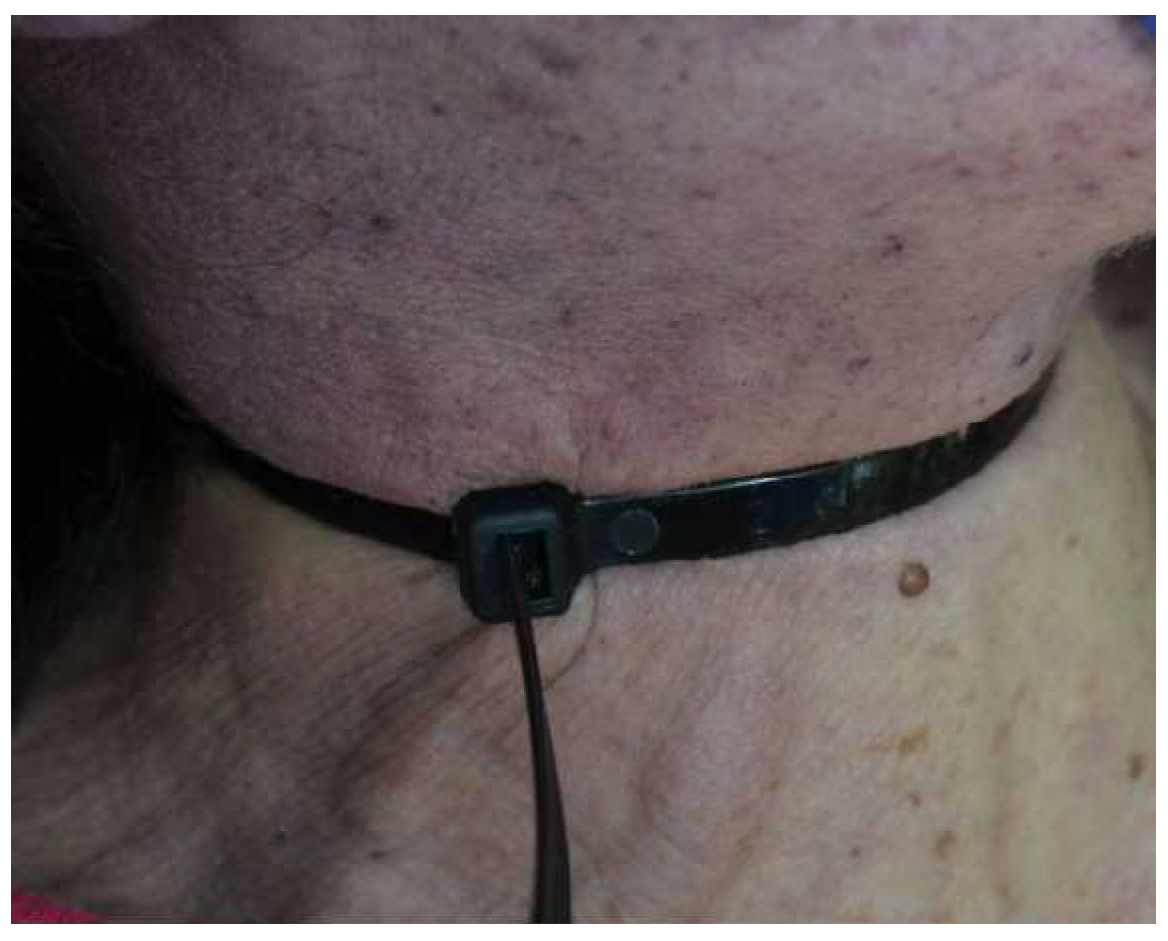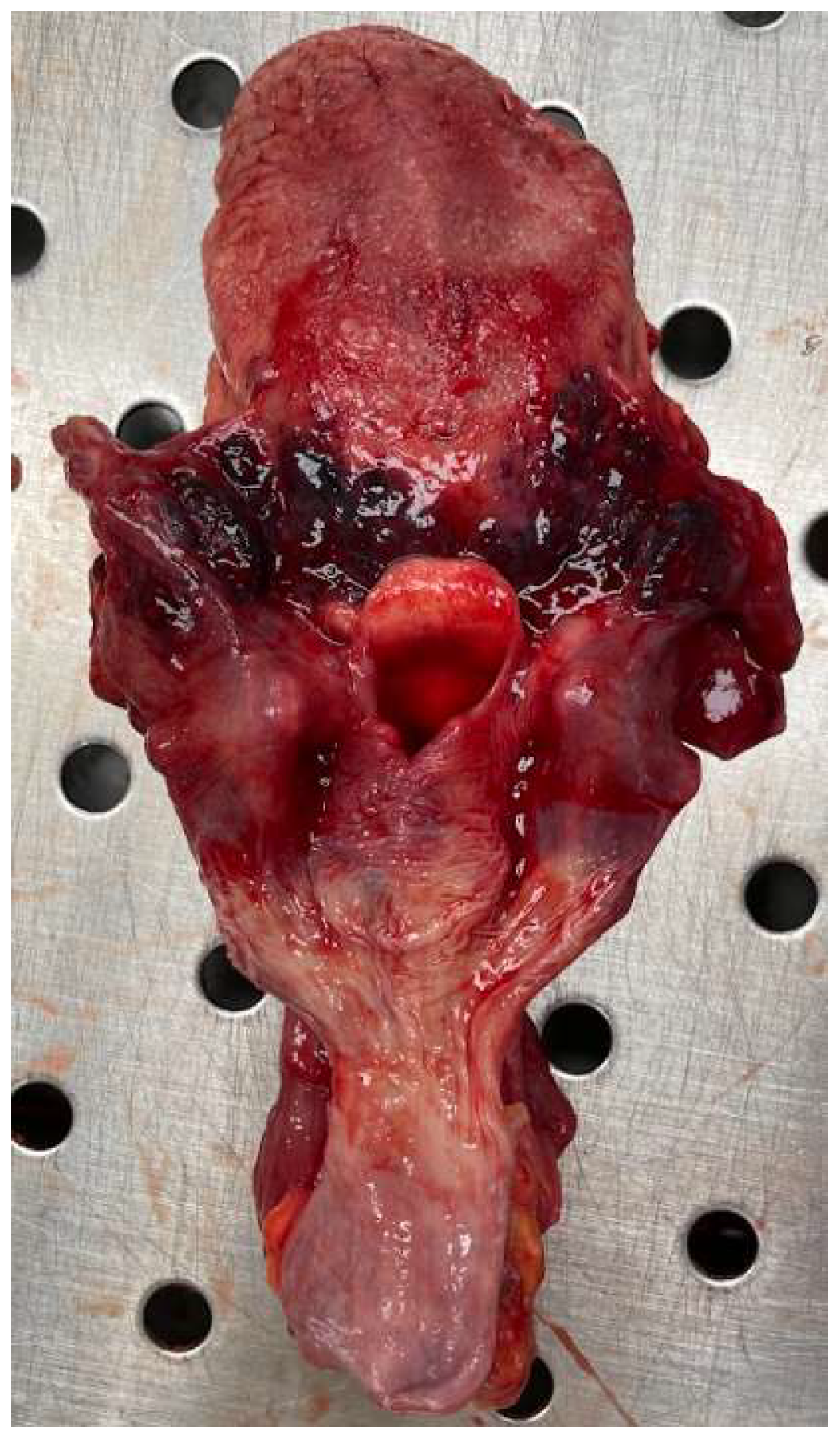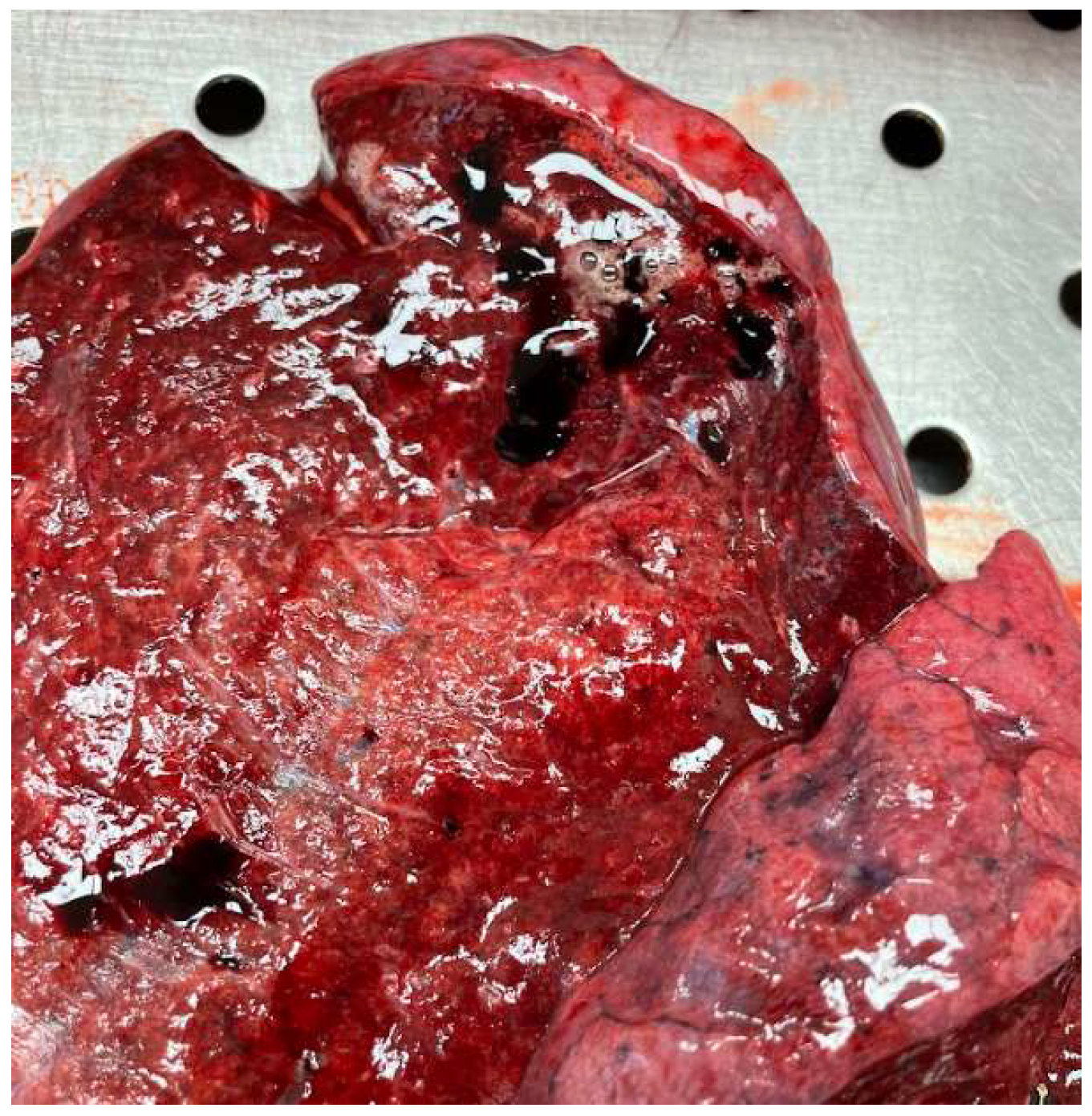Strangulation Using Cable Ties and a Suicidal Manner of Death: A Case Report and Literature Review Addressing an Atypical Suicidal Mode
Abstract
1. Introduction
2. Case Report
2.1. Medical History of the Victim and Circumstantial Data
2.2. External Examination of the Corpse
2.3. Autopsy Findings
2.4. Cause and Manner of Death
Differential Diagnosis Between Suicidal and Homicidal Manner
- -
- two cases of attempted suicide in the same way (mother and daughter);
- -
- the absence of DNA evidence or other injuries could be explained by, for example, the use of gloves by a potential killer;
- -
- the isolated location where the victim was found.
- -
- Psychiatric disorders can have a family component, and suicidal behaviour might be familiarly transmitted [17].
- -
- The mother also confirmed that she had attempted suicide in the same way and that her daughter, before committing suicide, had repeatedly expressed suicidal ideation.
- -
- The absence of DNA evidence alone is not decisive in identifying a suicide. However, the absence of any other injuries, while not specific, is extremely suggestive of suicide in this case. This statement is supported by the complete negativity of the toxicology tests, which suggest that the victim was conscious at the time of the event. Therefore, it is unlikely that a conscious individual would not attempt to free themselves from the cable tie in some way. In the case of a sleeping individual, it is highly improbable that the application of a cable tie would not cause them to wake up. If the individual were immobilized, it is unlikely that no injury would be found to the limbs.
- -
- The public place where the body was found (beside a cycle path by a river) may seem unusual for a suicide. Instead, as shown in the literature, public places are often chosen by suicide victims [18]. Furthermore, the investigations did not identify any elements that might suggest that the woman was not alone. Finally, there were no signs indicating that the body had been moved.
3. Narrative Review
3.1. Methods
3.2. Results
4. Discussion
5. Conclusions
Supplementary Materials
Author Contributions
Funding
Institutional Review Board Statement
Informed Consent Statement
Data Availability Statement
Acknowledgments
Conflicts of Interest
References
- Sauvageau, A.; Boghossian, E. Classification of asphyxia: The need for standardization. J. Forensic. Sci. 2010, 55, 1259–1267. [Google Scholar] [CrossRef] [PubMed]
- Sauvageau, A. About strangulation and hanging: Language matters. J. Emerg. Trauma Shock 2011, 4, 320. [Google Scholar] [CrossRef] [PubMed]
- Ajdacic-Gross, V.; Weiss, M.G.; Ring, M.; Hepp, U.; Bopp, M.; Gutzwiller, F.; Rössler, W. Methods of suicide: International suicide patterns derived from the WHO mortality database. Bull. World Health Organ. 2008, 86, 726–732. [Google Scholar] [CrossRef] [PubMed]
- Prahlow, J.; Byard, R.W. An Atlas of Forensic Pathology; Springer: Berlin/Heidelberg, Germany, 2012; pp. 633–916. [Google Scholar]
- Ma, J.; Jing, H.; Zeng, Y.; Tao, L.; Yang, Y.; Ma, K.; Chen, L. Retrospective analysis of 319 hanging and strangulation cases between 2001 and 2014 in Shanghai. J. Forensic Leg. Med. 2016, 42, 19–24. [Google Scholar] [CrossRef] [PubMed]
- Demirci, S.; Dogan, K.H.; Erkol, Z.; Gunaydin, G. Suicide by ligature strangulation: Three case reports. Am. J. Forensic Med. Pathol. 2009, 30, 369–722. [Google Scholar] [CrossRef]
- Cordner, S.; Clay, F.J.; Bassed, R.; Thomsen, A.H. Suicidal ligature strangulation: A systematic review of the published literature. Forensic Sci. Med. Pathol. 2020, 16, 123–133. [Google Scholar] [CrossRef]
- Sorokin, V.; Persechino, F.; DeRoux, S.J.; Greenberg, M.J. Suicidal ligature strangulation utilizing cable ties: A report of three cases. Forensic Sci. Med. Pathol. 2012, 8, 52–55. [Google Scholar] [CrossRef]
- Doberentz, E.; Markwerth, P.; Madea, B. Differentiation of homicidal or suicidal strangulation. Forensic Sci. Int. 2019, 301, e44–e48. [Google Scholar] [CrossRef]
- Maxeiner, H.; Bockholdt, B. Homicidal and suicidal ligature strangulation--A comparison of the post-mortem findings. Forensic Sci. Int. 2003, 137, 60–66. [Google Scholar] [CrossRef]
- Bachmann, S. Epidemiology of Suicide and the Psychiatric Perspective. Int. J. Environ. Res. Public Health 2018, 15, 1425. [Google Scholar] [CrossRef]
- Janík, M.; Krajčovič, J.; Novomeský, F.; Straka, Ľ.; Hejna, P. Wheelchair-Assisted Ligature Strangulation: An Unusual Suicide by a Quadriparetic. Am. J. Forensic Med. Pathol. 2019, 40, 160–164. [Google Scholar] [CrossRef] [PubMed]
- Mohanty, M.K.; Rastogi, P.; Kumar, G.P.; Kumar, V.; Manipady, S. Periligature injuries in hanging. J. Clin. Forensic Med. 2003, 10, 255–258. [Google Scholar] [CrossRef] [PubMed]
- Hawton, K.; Comabella, C.C.I.; Haw, C.; Saunders, K. Risk factors for suicide in individuals with depression: A systematic review. J. Affect. Disord. 2013, 147, 17–28. [Google Scholar] [CrossRef] [PubMed]
- Owens, C.; Lloyd-Tomlins, S.; Emmens, T.; Aitken, P. Suicides in public places: Findings from one English county. Eur. J. Public Health 2009, 19, 580–582. [Google Scholar] [CrossRef]
- Song, F.; Liu, Y.; He, Q.; Hou, W.; Wei, F.; Liu, L. DNA analysis of fingernail clippings: An unusual case report. Am. J. Forensic Med. Pathol. 2014, 35, 96–99. [Google Scholar] [CrossRef]
- Bohnert, M.; Faller-Marquardt, M.; Lutz, S.; Amberg, R.; Weisser, H.J.; Pollak, S. Transfer of biological traces in cases of hanging and ligature strangulation. Forensic Sci. Int. 2001, 116, 107–115. [Google Scholar] [CrossRef]
- Lee, G.; Hu, K.S. A rare case of ligature strangulation using a dental unit: Distinguishing suicide from homicide in a death scene investigation. J. Forensic Sci. 2022, 67, 2487–2491. [Google Scholar] [CrossRef]
- Pramod Kumar, G.N.; Arun, M.; Manjunatha, B.; Balaraj, B.M.; Verghese, A.J. Suicidal strangulation by plastic lock tie. J. Forensic Leg. Med. 2013, 20, 60–62. [Google Scholar] [CrossRef]
- Wittig, H.; Grünewald, S.; Gerlach, K.; Dussy, F.; Scheurer, E. Suicidal ligature strangulation using cable ties: Case report and postmortem angiography results. Rechtsmed 2017, 27, 433–437. [Google Scholar] [CrossRef]
- Langlois, N.E.; Byard, R.W. Cable tie suicide. Forensic Sci. Med. Pathol. 2017, 13, 110–112. [Google Scholar] [CrossRef]
- Jackson, N.R.; Paul, I.D. An Unusual Method of Suicide: Cable Ties. Am. J. Forensic Med. Pathol. 2020, 41, 223–226. [Google Scholar] [CrossRef] [PubMed]
- Mugoma, S.; Phokedi, G.N. Suicidal ligature strangulation utilizing doubled cable ties—A case report. Forensic Sci. Int. 2020, 2, 100098. [Google Scholar] [CrossRef]
- Acinas, M.P.; Robles, J.I.; Peláez-Fernández, M.Á. Suicide note and the psychological autopsy: Associated behavioral aspects. Actas Esp. Psiquiatr. 2015, 43, 69–79. [Google Scholar] [PubMed]
- Lang, A.; Brieger, P.; Menzel, S.; Hamann, J. Differences between suicide note leavers and other suicides: A German psychological autopsy study. J. Psychiatry Res. 2021, 137, 173–177. [Google Scholar] [CrossRef]
- Paraschakis, A.; Michopoulos, I.; Douzenis, A.; Christodoulou, C.; Koutsaftis, F.; Lykouras, L. Differences between suicide victims who leave notes and those who do not: A 2-year study in Greece. Crisis 2012, 33, 344–349. [Google Scholar] [CrossRef]
- Bostwick, J.M.; Pabbati, C.; Geske, J.R.; McKean, A.J. Suicide Attempt as a Risk Factor for Completed Suicide: Even More Lethal Than We Knew. Am. J. Psychiatry 2016, 173, 1094–1100. [Google Scholar] [CrossRef]
- Owens, D.; Horrocks, J.; House, A. Fatal and non-fatal repetition of self-harm. Systematic review. Br. J. Psychiatry 2002, 181, 193–199. [Google Scholar] [CrossRef]
- Belli, G.; Bolcato, V.; Quaiotti, J.; Cassinari, D.; Tarchi, L.; Tronconi, L.; Damiani, S.; Brondino, N.; Politi, B.P.; Moretti, M. Overview of the suicidal phenomenon in twenty-years autopsies at the Legal Medicine Unit of Pavia. Ethic-Med. Public Heal 2022, 21, 100756. [Google Scholar] [CrossRef]
- Cioffi, A.; Cecannecchia, C.; Bertozzi, G.; Cipolloni, L.; Baldari, B. Unusual suicide with an electric Jigsaw: A case report and literature review. J. Forensic Leg. Med. 2022, 89, 102372. [Google Scholar] [CrossRef]
- Favril, L.; Yu, R.; Uyar, A.; Sharpe, M.; Fazel, S. Risk factors for suicide in adults: Systematic review and meta-analysis of psychological autopsy studies. BMJ Ment. Health 2022, 25, 148–155. [Google Scholar] [CrossRef]
- World Health Organization (WHO). Suicide. 29 August 2024. Available online: https://www.who.int/news-room/fact-sheets/detail/suicide (accessed on 27 September 2024).
- Pinto, S.L.; Tacchella, T.; Fossati, F.; Bonsignore, A.; Ventura, F. Self-Strangulation Through A Sphygmomanometer: An Uncommon Suicide. J. Forensic Sci. 2017, 62, 528–530. [Google Scholar] [CrossRef]
- Choromanski, K. Bloodstain Pattern Analysis in Crime Scienarios. Springer: Singapore, 2020. [Google Scholar]
- Teke, H.Y.; Alkan, H.A.; Değirmenci, B. Mechanical asphyxiation due to ligature strangulation: A case report of suicide. Scand. J. Forensic Sci. 2019, 25, 1–4. [Google Scholar] [CrossRef]
- Di Maio, V.J.M.; Di Maio, D.J. Forensic Pathology, 2nd ed.; CRC Press: Boca Raton, FL, USA, 2001. [Google Scholar]





| Sex | Age | Ligature Tool(s) | Psychiatric History | Anti-Conservative Behaviours | Suicide Note | Haemorrhagic Petechiae | Haemorrhagic Infiltration of Neck Soft Tissues | Fractures in the Neck Structures | Toxicology Report | |
|---|---|---|---|---|---|---|---|---|---|---|
| [8] Case 1 | M | 37 | Two cable ties and a belt | Positive | No | Absent | Conjunctival | Absent | Absent | Positive |
| [8] Case 2 | F | 63 | Multiple cable ties | Positive | No | Absent | Conjunctival, facial, and on the neck | Multiple, small, focal | Absent | Positive |
| [8] Case 3 | M | 54 | Two cable ties | Positive | Yes | Present | Absent ** | Absent ** | Absent | Positive |
| [19] | M | 50 | One cable tie | Negative * | No * | Present | Conjunctival | Contusion of the neck muscles | Absent | Positive |
| [20] | M | 75 | One cable tie | Positive | Yes | Absent | Facial | Small amount of bleeding | Absent | Positive |
| [21] | M | 48 | Multiple cable ties | Negative * | No * | Present | Conjunctival | Right thyrohyoid muscle | Absent | Negative |
| [22] | M | 40 | Two cable ties | Positive | No | Present | Conjunctival and palpebral | Absent | Absent | Unspecified |
| [23] | M | 25 | Two cable ties | Negative * | No * | Absent | Conjunctival and on the mouth mucosa | Contusion of the neck muscles | Absent | Positive |
Disclaimer/Publisher’s Note: The statements, opinions and data contained in all publications are solely those of the individual author(s) and contributor(s) and not of MDPI and/or the editor(s). MDPI and/or the editor(s) disclaim responsibility for any injury to people or property resulting from any ideas, methods, instructions or products referred to in the content. |
© 2024 by the authors. Licensee MDPI, Basel, Switzerland. This article is an open access article distributed under the terms and conditions of the Creative Commons Attribution (CC BY) license (https://creativecommons.org/licenses/by/4.0/).
Share and Cite
Cecannecchia, C.; De Simone, S.; Baldari, B.; Cipolloni, L.; Cioffi, A. Strangulation Using Cable Ties and a Suicidal Manner of Death: A Case Report and Literature Review Addressing an Atypical Suicidal Mode. Forensic Sci. 2025, 5, 1. https://doi.org/10.3390/forensicsci5010001
Cecannecchia C, De Simone S, Baldari B, Cipolloni L, Cioffi A. Strangulation Using Cable Ties and a Suicidal Manner of Death: A Case Report and Literature Review Addressing an Atypical Suicidal Mode. Forensic Sciences. 2025; 5(1):1. https://doi.org/10.3390/forensicsci5010001
Chicago/Turabian StyleCecannecchia, Camilla, Stefania De Simone, Benedetta Baldari, Luigi Cipolloni, and Andrea Cioffi. 2025. "Strangulation Using Cable Ties and a Suicidal Manner of Death: A Case Report and Literature Review Addressing an Atypical Suicidal Mode" Forensic Sciences 5, no. 1: 1. https://doi.org/10.3390/forensicsci5010001
APA StyleCecannecchia, C., De Simone, S., Baldari, B., Cipolloni, L., & Cioffi, A. (2025). Strangulation Using Cable Ties and a Suicidal Manner of Death: A Case Report and Literature Review Addressing an Atypical Suicidal Mode. Forensic Sciences, 5(1), 1. https://doi.org/10.3390/forensicsci5010001








